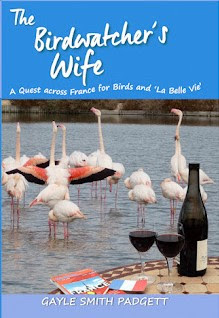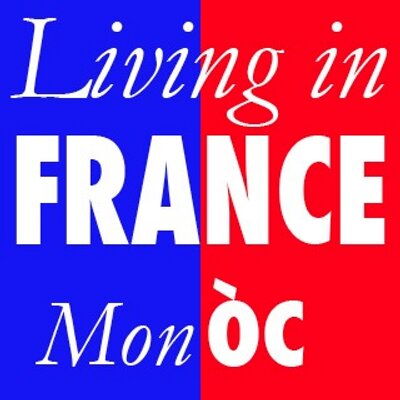.jpg) Some years ago, after finishing the book "French Dirt: The Story of a Garden in the South of France," I did something I’ve never done: I wrote a fan letter to Richard Goodman, the author. He and I went on to become friends and, because I admire his work so much, I asked him to pen something for The Provence Post, on any subject of his choosing. This is what he sent.
What I miss in most of the books and articles I read about Provence is not the food, the wine, the light and so on. It’s books. It’s the literature. I miss the recognition, praise, and the kind of understanding of this culture that can only be gained through its authors. Yes, food and wine and light will tell you quite a bit about a people, but if you don’t know what its sons and daughters have written about the place, if you haven’t seen its spirit distilled and energized and poeticized through their hearts and minds on paper, I don’t think you can truly claim you know Provence. To me, asserting you know Provence without having read Jean Giono, Marcel Pagnol, Frederic Mistral, Colette and others is like claiming you know America without having read Twain, Melville, Dickinson, Hemingway and Faulkner. It’s an incomplete claim.I distrust any person who writes seriously about Provence who does not at least glancingly refer to its writers.
Two figures stand out. Marcel Pagnol and Jean Giono. Pagnol is the far better known of the two. But Giono, a very different writer, deserves at least as much fame. Giono and Pagnol were almost exact contemporaries. Giono (1895-1970) lived his life in the town of Manosque in Haute Provence. Pagnol (1895-1974) spent his youth in Aubagne, near Marseille. Even in such a geographically limited area as Provence, there are major differences in landscape, such as these, and they encouraged very different kinds of writing.
Pagnol was a dramatist, memoirist, novelist and filmmaker. He made films out of several of Giono’s books, and they are wonderful to see; La Femme du Boulanger is exquisite and deeply moving. Many people have read Pagnol’s memoir of growing up in Aubagne, My Father’s Glory, and it’s delightful, but I like Pagnol’s plays best, particularly, Marius, Fanny and César. Set on Marseille’s Old Port, they are compassionate, funny, touching, sweet and powerful. It doesn’t matter that that world no longer exists. The hearts of its people do.
Giono is, to my mind, a mystical writer. I’ve never read anyone like him. Not all of his books have been translated into English, but enough have, and you can always start with his famous short book, The Man Who Planted Trees. One of his other better known books, Joy of Man’s Desiring, is available in English. I love Les Grands Chemins, which I do not think is available in English. He loves and respects the farmers and shepherds in his books, the everyday man and woman, so you might compare his work to Sherwood Anderson’s Winesburg, Ohio, though Giono is more poetic, and closer to the earth.
In any case, I would say: if you truly want to know Provence, to feel close to the place in a way you just can’t otherwise, read. Read its great authors. Begin with Giono and Pagnol. There are no greater spirits who have walked and loved this land.
Richard Goodman lived in Provence in 1988-'89, in a small village near Nimes, and again, in 1991-'92, in Sanary-sur-Mer. In addition to "French Dirt," he’s the author of "The Soul of Creative Writing." Today he writes for the New York Times, Harvard Review, Vanity Fair, Garden Design, The Writer's Chronicle, French Review and others while conducting writing workshops throughout the U.S. He lives in New York City and can be reached at: www.richardgoodman.org, rgoodman71@hotmail.com.
To buy French Dirt: French Dirt: The Story of a Garden in the South of France
Some years ago, after finishing the book "French Dirt: The Story of a Garden in the South of France," I did something I’ve never done: I wrote a fan letter to Richard Goodman, the author. He and I went on to become friends and, because I admire his work so much, I asked him to pen something for The Provence Post, on any subject of his choosing. This is what he sent.
What I miss in most of the books and articles I read about Provence is not the food, the wine, the light and so on. It’s books. It’s the literature. I miss the recognition, praise, and the kind of understanding of this culture that can only be gained through its authors. Yes, food and wine and light will tell you quite a bit about a people, but if you don’t know what its sons and daughters have written about the place, if you haven’t seen its spirit distilled and energized and poeticized through their hearts and minds on paper, I don’t think you can truly claim you know Provence. To me, asserting you know Provence without having read Jean Giono, Marcel Pagnol, Frederic Mistral, Colette and others is like claiming you know America without having read Twain, Melville, Dickinson, Hemingway and Faulkner. It’s an incomplete claim.I distrust any person who writes seriously about Provence who does not at least glancingly refer to its writers.
Two figures stand out. Marcel Pagnol and Jean Giono. Pagnol is the far better known of the two. But Giono, a very different writer, deserves at least as much fame. Giono and Pagnol were almost exact contemporaries. Giono (1895-1970) lived his life in the town of Manosque in Haute Provence. Pagnol (1895-1974) spent his youth in Aubagne, near Marseille. Even in such a geographically limited area as Provence, there are major differences in landscape, such as these, and they encouraged very different kinds of writing.
Pagnol was a dramatist, memoirist, novelist and filmmaker. He made films out of several of Giono’s books, and they are wonderful to see; La Femme du Boulanger is exquisite and deeply moving. Many people have read Pagnol’s memoir of growing up in Aubagne, My Father’s Glory, and it’s delightful, but I like Pagnol’s plays best, particularly, Marius, Fanny and César. Set on Marseille’s Old Port, they are compassionate, funny, touching, sweet and powerful. It doesn’t matter that that world no longer exists. The hearts of its people do.
Giono is, to my mind, a mystical writer. I’ve never read anyone like him. Not all of his books have been translated into English, but enough have, and you can always start with his famous short book, The Man Who Planted Trees. One of his other better known books, Joy of Man’s Desiring, is available in English. I love Les Grands Chemins, which I do not think is available in English. He loves and respects the farmers and shepherds in his books, the everyday man and woman, so you might compare his work to Sherwood Anderson’s Winesburg, Ohio, though Giono is more poetic, and closer to the earth.
In any case, I would say: if you truly want to know Provence, to feel close to the place in a way you just can’t otherwise, read. Read its great authors. Begin with Giono and Pagnol. There are no greater spirits who have walked and loved this land.
Richard Goodman lived in Provence in 1988-'89, in a small village near Nimes, and again, in 1991-'92, in Sanary-sur-Mer. In addition to "French Dirt," he’s the author of "The Soul of Creative Writing." Today he writes for the New York Times, Harvard Review, Vanity Fair, Garden Design, The Writer's Chronicle, French Review and others while conducting writing workshops throughout the U.S. He lives in New York City and can be reached at: www.richardgoodman.org, rgoodman71@hotmail.com.
To buy French Dirt: French Dirt: The Story of a Garden in the South of FranceThursday, December 11, 2008
Provence on Paper
.jpg) Some years ago, after finishing the book "French Dirt: The Story of a Garden in the South of France," I did something I’ve never done: I wrote a fan letter to Richard Goodman, the author. He and I went on to become friends and, because I admire his work so much, I asked him to pen something for The Provence Post, on any subject of his choosing. This is what he sent.
What I miss in most of the books and articles I read about Provence is not the food, the wine, the light and so on. It’s books. It’s the literature. I miss the recognition, praise, and the kind of understanding of this culture that can only be gained through its authors. Yes, food and wine and light will tell you quite a bit about a people, but if you don’t know what its sons and daughters have written about the place, if you haven’t seen its spirit distilled and energized and poeticized through their hearts and minds on paper, I don’t think you can truly claim you know Provence. To me, asserting you know Provence without having read Jean Giono, Marcel Pagnol, Frederic Mistral, Colette and others is like claiming you know America without having read Twain, Melville, Dickinson, Hemingway and Faulkner. It’s an incomplete claim.I distrust any person who writes seriously about Provence who does not at least glancingly refer to its writers.
Two figures stand out. Marcel Pagnol and Jean Giono. Pagnol is the far better known of the two. But Giono, a very different writer, deserves at least as much fame. Giono and Pagnol were almost exact contemporaries. Giono (1895-1970) lived his life in the town of Manosque in Haute Provence. Pagnol (1895-1974) spent his youth in Aubagne, near Marseille. Even in such a geographically limited area as Provence, there are major differences in landscape, such as these, and they encouraged very different kinds of writing.
Pagnol was a dramatist, memoirist, novelist and filmmaker. He made films out of several of Giono’s books, and they are wonderful to see; La Femme du Boulanger is exquisite and deeply moving. Many people have read Pagnol’s memoir of growing up in Aubagne, My Father’s Glory, and it’s delightful, but I like Pagnol’s plays best, particularly, Marius, Fanny and César. Set on Marseille’s Old Port, they are compassionate, funny, touching, sweet and powerful. It doesn’t matter that that world no longer exists. The hearts of its people do.
Giono is, to my mind, a mystical writer. I’ve never read anyone like him. Not all of his books have been translated into English, but enough have, and you can always start with his famous short book, The Man Who Planted Trees. One of his other better known books, Joy of Man’s Desiring, is available in English. I love Les Grands Chemins, which I do not think is available in English. He loves and respects the farmers and shepherds in his books, the everyday man and woman, so you might compare his work to Sherwood Anderson’s Winesburg, Ohio, though Giono is more poetic, and closer to the earth.
In any case, I would say: if you truly want to know Provence, to feel close to the place in a way you just can’t otherwise, read. Read its great authors. Begin with Giono and Pagnol. There are no greater spirits who have walked and loved this land.
Richard Goodman lived in Provence in 1988-'89, in a small village near Nimes, and again, in 1991-'92, in Sanary-sur-Mer. In addition to "French Dirt," he’s the author of "The Soul of Creative Writing." Today he writes for the New York Times, Harvard Review, Vanity Fair, Garden Design, The Writer's Chronicle, French Review and others while conducting writing workshops throughout the U.S. He lives in New York City and can be reached at: www.richardgoodman.org, rgoodman71@hotmail.com.
To buy French Dirt: French Dirt: The Story of a Garden in the South of France
Some years ago, after finishing the book "French Dirt: The Story of a Garden in the South of France," I did something I’ve never done: I wrote a fan letter to Richard Goodman, the author. He and I went on to become friends and, because I admire his work so much, I asked him to pen something for The Provence Post, on any subject of his choosing. This is what he sent.
What I miss in most of the books and articles I read about Provence is not the food, the wine, the light and so on. It’s books. It’s the literature. I miss the recognition, praise, and the kind of understanding of this culture that can only be gained through its authors. Yes, food and wine and light will tell you quite a bit about a people, but if you don’t know what its sons and daughters have written about the place, if you haven’t seen its spirit distilled and energized and poeticized through their hearts and minds on paper, I don’t think you can truly claim you know Provence. To me, asserting you know Provence without having read Jean Giono, Marcel Pagnol, Frederic Mistral, Colette and others is like claiming you know America without having read Twain, Melville, Dickinson, Hemingway and Faulkner. It’s an incomplete claim.I distrust any person who writes seriously about Provence who does not at least glancingly refer to its writers.
Two figures stand out. Marcel Pagnol and Jean Giono. Pagnol is the far better known of the two. But Giono, a very different writer, deserves at least as much fame. Giono and Pagnol were almost exact contemporaries. Giono (1895-1970) lived his life in the town of Manosque in Haute Provence. Pagnol (1895-1974) spent his youth in Aubagne, near Marseille. Even in such a geographically limited area as Provence, there are major differences in landscape, such as these, and they encouraged very different kinds of writing.
Pagnol was a dramatist, memoirist, novelist and filmmaker. He made films out of several of Giono’s books, and they are wonderful to see; La Femme du Boulanger is exquisite and deeply moving. Many people have read Pagnol’s memoir of growing up in Aubagne, My Father’s Glory, and it’s delightful, but I like Pagnol’s plays best, particularly, Marius, Fanny and César. Set on Marseille’s Old Port, they are compassionate, funny, touching, sweet and powerful. It doesn’t matter that that world no longer exists. The hearts of its people do.
Giono is, to my mind, a mystical writer. I’ve never read anyone like him. Not all of his books have been translated into English, but enough have, and you can always start with his famous short book, The Man Who Planted Trees. One of his other better known books, Joy of Man’s Desiring, is available in English. I love Les Grands Chemins, which I do not think is available in English. He loves and respects the farmers and shepherds in his books, the everyday man and woman, so you might compare his work to Sherwood Anderson’s Winesburg, Ohio, though Giono is more poetic, and closer to the earth.
In any case, I would say: if you truly want to know Provence, to feel close to the place in a way you just can’t otherwise, read. Read its great authors. Begin with Giono and Pagnol. There are no greater spirits who have walked and loved this land.
Richard Goodman lived in Provence in 1988-'89, in a small village near Nimes, and again, in 1991-'92, in Sanary-sur-Mer. In addition to "French Dirt," he’s the author of "The Soul of Creative Writing." Today he writes for the New York Times, Harvard Review, Vanity Fair, Garden Design, The Writer's Chronicle, French Review and others while conducting writing workshops throughout the U.S. He lives in New York City and can be reached at: www.richardgoodman.org, rgoodman71@hotmail.com.
To buy French Dirt: French Dirt: The Story of a Garden in the South of France
Labels:
BOOKS,
GUEST BLOGGERS,
PROVENCE
Subscribe to:
Post Comments (Atom)






























































.jpg)









No comments:
Post a Comment